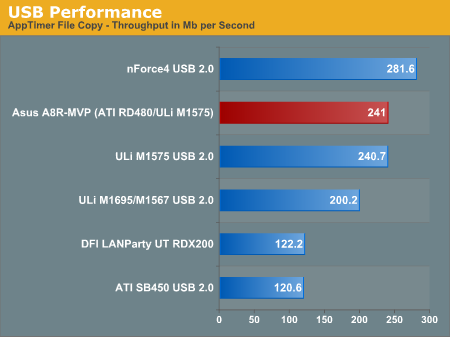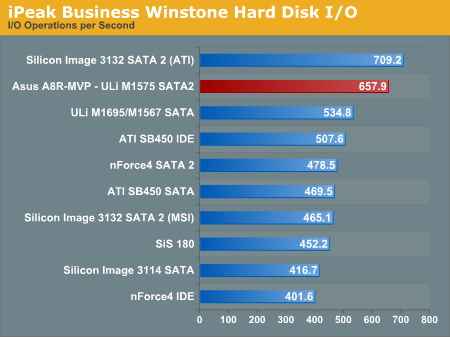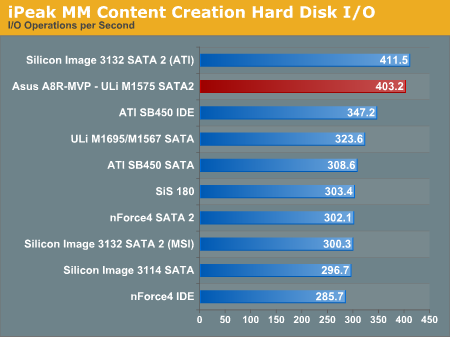Asus A8R-MVP: Mainstream Rocket
by Wesley Fink on November 23, 2005 1:15 AM EST- Posted in
- Motherboards
USB Performance
USB has been a problem area for the ATI SB450 chipset, so we were anxious to test the ULi M1575 South Bridge, which is supposed to fix USB performance issues. We ran our standard USB throughput test on the Asus A8R-MVP using an external USB hard drive.
Our test method uses a RAM disk as our “server”, since memory removes almost all overhead from the serving end. We also disable disk caching on the USB and Firewire side by setting up the drives for “quick disconnect”. Our results are then consistent over many test runs.
We use just 1GB of fast 2-2-2 system memory, set up as a 450MB RAM disk and 550MB of system memory. Our stock file is the SPECviewPerf 8.01 install file. which is 432,533,504 bytes (412.4961MB). After copying this file to our RAM disk, we measure the time for writing from the RAM disk to our external USB 2.0 or Firewire 400 or Firewire 800 drive using a Windows timing program written for AnandTech by our own Jason Clark. The copy times in seconds are then converted into Megabits per second (Mb) to provide a convenient means of comparing throughput. Higher Rates therefore mean better performance.
In addition to competitive USB performance, the M1575 also provides the SATA2 ports that are missing from the ATI SB450. The ULi SATA2 also supports RAID 0, 1, 0+1, 5, and JBOD.
Disk Controller Performance
With the variety of disk drive benchmarks available, we needed a means of comparing the true performance of the wide selection of controllers. The logical choice was Anand's storage benchmark first described in “Q2 2004 Desktop Hard Drive Comparison: WD Raptor vs. the World”. To refresh your memory, the iPeak test was designed to measure "pure" hard disk performance, and in this case, we kept the hard drive as consistent as possible while varying the hard drive controller. The idea is to measure the performance of a hard drive controller with a consistent hard drive.
We played back Anand's raw files that recorded I/O operations when running a real world benchmark - the entire Winstone 2004 suite. Intel's iPEAK utility was then used to play back the trace file of all IO operations that took place during a single run of Business Winstone 2004 and MCC Winstone 2004. The drive was formatted before each test run and a composite average of 5 tests on each controller interface was tabulated in order to ensure consistency in the benchmark.
iPeak gives a mean service time in milliseconds; in other words, the average time that each drive took to fulfill each IO operation. In order to make the data more understandable, we report the scores as an average number of IO operations per second so that higher scores translate into better performance. This number is meaningless as far as hard disk performance is concerned as it is just the number of IO operations completed in a second. However, the scores are useful for comparing "pure" performance of the storage controllers in this case.
USB has been a problem area for the ATI SB450 chipset, so we were anxious to test the ULi M1575 South Bridge, which is supposed to fix USB performance issues. We ran our standard USB throughput test on the Asus A8R-MVP using an external USB hard drive.
Our test method uses a RAM disk as our “server”, since memory removes almost all overhead from the serving end. We also disable disk caching on the USB and Firewire side by setting up the drives for “quick disconnect”. Our results are then consistent over many test runs.
We use just 1GB of fast 2-2-2 system memory, set up as a 450MB RAM disk and 550MB of system memory. Our stock file is the SPECviewPerf 8.01 install file. which is 432,533,504 bytes (412.4961MB). After copying this file to our RAM disk, we measure the time for writing from the RAM disk to our external USB 2.0 or Firewire 400 or Firewire 800 drive using a Windows timing program written for AnandTech by our own Jason Clark. The copy times in seconds are then converted into Megabits per second (Mb) to provide a convenient means of comparing throughput. Higher Rates therefore mean better performance.

In addition to competitive USB performance, the M1575 also provides the SATA2 ports that are missing from the ATI SB450. The ULi SATA2 also supports RAID 0, 1, 0+1, 5, and JBOD.
Disk Controller Performance
With the variety of disk drive benchmarks available, we needed a means of comparing the true performance of the wide selection of controllers. The logical choice was Anand's storage benchmark first described in “Q2 2004 Desktop Hard Drive Comparison: WD Raptor vs. the World”. To refresh your memory, the iPeak test was designed to measure "pure" hard disk performance, and in this case, we kept the hard drive as consistent as possible while varying the hard drive controller. The idea is to measure the performance of a hard drive controller with a consistent hard drive.
We played back Anand's raw files that recorded I/O operations when running a real world benchmark - the entire Winstone 2004 suite. Intel's iPEAK utility was then used to play back the trace file of all IO operations that took place during a single run of Business Winstone 2004 and MCC Winstone 2004. The drive was formatted before each test run and a composite average of 5 tests on each controller interface was tabulated in order to ensure consistency in the benchmark.
iPeak gives a mean service time in milliseconds; in other words, the average time that each drive took to fulfill each IO operation. In order to make the data more understandable, we report the scores as an average number of IO operations per second so that higher scores translate into better performance. This number is meaningless as far as hard disk performance is concerned as it is just the number of IO operations completed in a second. However, the scores are useful for comparing "pure" performance of the storage controllers in this case.












74 Comments
View All Comments
james007 - Thursday, February 16, 2006 - link
Hi, I deeply appreciate the hard work and thought that went into this article. I'm not a 'gamer' though -- I'm trying to select the fastest available mobo for software development. Visual Studio 2005 is a dog, dawg! I don't mind dropping a few hundred for speed.. so what are y'all's thoughts: what's the fastest mobo? A8R-MVP, or A8N32-SLI? Or another board?+ I'm still trying to select the snappiest hard drive. SCSI (like, Cheetah) or Sata?
Thanx for your advice and for lending us the benefits of your experience.
JH
htcstech - Wednesday, February 1, 2006 - link
Apologies for my ignorance, but did you test the motherboard overclocked or as standard?If either OC or standard, have you posted the other results?
Thanks
superkdogg - Monday, January 16, 2006 - link
Hey Wes,Did you really get that 325x9 @ 1.300 vCore like the screenshot on the first page says?
If so, you had a fantastic setup going. I'm looking forward to getting my board (despite the numerous complaints about vCore not as advertised). I can deal with the memory issues (real or user-based) because I'm still rocking the Corsair VS with dividers anyway.
tanstudio - Thursday, January 12, 2006 - link
I have a a8r mvp and opteron 146 running stable at 2.6G with 1.45V. I can boot into 2.7G but soon windows hangged. And the max cpu voltage I can have is 1.45V with this motherboard. It would be great if the board can have 1.5-1.65 v cop voltage so my opteron 146 may have a chance to hit 2.8G with 1.5V or 1.55V core voltage.Beenthere - Sunday, January 8, 2006 - link
As many people who have purchased the A8R-MVP Mobo have sadly discovered, there are some serious issues with the production Mobos that Anandtech did not experience with their review board. Specifically the Mobo does NOT provide CPU Vcore voltages above 1.40V and many if not most people who have purchased this Mobo have been unable to run memory at 1T above 250 MHz even though the same memory runs fine on other Mobos above 250 MHz at 1T with no problem. The voltage issue is serious because Asus clearly advertises the A8R-MVP for use with all socket 939 Athlon / FX / X2 CPUs, which of course is impossible as the (CG) Clawhammer core chips require a MINIMUM 1.50V, which isn't even an option on the A8R-MVP Mobo.After careful review of a number of factors I have a suspicion that the A8R-MVP has limited Vcore current capacity and that is why Asus has refused to provide the proper voltage options in the BIOS. I suspect after they produced the Mobo they discovered the shortcoming and so limited the voltage options because the current draw increases as you O/C the CPU, which is only possible if you can raise the voltage, in most cases. This is just my theory but if Asus could provide the proper CPU voltages for the CG core CPUs then you'd have thought after two BIOS updates they would have...
From my perspective this is simply unacceptable as any Clawhammer based CPU requires a minimum 1.50V per AMD. Asus has advertised the A8R-MVP as being fully Athlon / FX / X2 compatible and even states in their online Tech Section that the FX-55 and 4000+ are fully supported on this Mobo - which of course they ARE NOT as they require a MINIMUM 1.50V, which is not even an option on the A8R-MVP.
My suggestion is that people STOP BUYING THIS MOBO if you need a minimum 1.50V Vcore. Anyone who can return their A8R-MVP under warranty would be advised to do so. If you have an FX-55 or 4000+ that requires 1.50V per AMD, then you can't run it on this Mobo despite Asus' claims of fitment. That's my view of things based on what I see and I'd suggest potential purchasers of this Mobo be advised of the unusually low CPU voltage options PRIOR to purchase as you may need to return the Mobo if your CPU requires 1.50 or more volts to function properly.
Wesley Fink - Sunday, January 15, 2006 - link
Your information is not completely true - but you already know this. The vCore of the A8R-MVP varies according to the CPU installed. It does NOT stop at 1.4V with a Clawhammer. The range available varies with the CPU and is always 0.0v to 0.1v more than the default voltage of the CPU. When we tested the board Asus advised that the additional overvolt option in the BIOS added 0.2V more vCore. After measuring several boards the actual addition of the overvolt jumper is 0.1V.The range is not quite as wide as what we initially reported, but it is not nearly as limited as what you report. If you plan to post this in every Forum that mentions the A8R-MVP you need to at least get your facts correct. The limit is not 1.65V with a 1.45V processor, but it is alos not the 1.4V you imply. Fo most recent AMD processors increasing vCore does little for overclocking anyway. You are better off using the chipset and HTT overvolt. No doubt many would welcome a range to 1.7V, but the design of the A8R-MVP does not make that a likely prospect. I also did not need the much higher vCore to reach 325FSB in my testing.
What I am finding in emails is about half can duplicate results I found, while the other half have difficulty getting above 250-260. It does appear there may be quite a bit of variation in the OC performance of the shipping RD480 chipsets - and that there are chipsets out there that OC well and half that don't overclock as well.
dlxhammer - Tuesday, January 10, 2006 - link
Thanks for the info Beenthere, but sadly i have already ordered this mobo, along with an x1800xt. I WAS planning on using my current cpu (amd 3500 clawhammer) and you are correct the voltage is 1.5Maby its time to upgrade my cpu:\ I notice the AMD dual core processors require 1.35-1.4 volts would this be a wise choice? maby ill give my current cpu a shot 1st...
tmodel37 - Monday, December 19, 2005 - link
Hi Wes,Since I cannot find the A8n32 SLI Deluxe anywhere, the A8n-MVP sounds great, but I already have 2 7800GT's. Where can I get the hacked drivers? I am 68 yr. old newbie, and need all the help I can get.
Ryan Norton - Monday, December 12, 2005 - link
Feedback thread:http://forums.anandtech.com/messageview.aspx?catid...">http://forums.anandtech.com/messageview...9&th...
I took it up to 325HTT last night in 5MHz increments and let it run Memtest all night, still rock solid. A couple anomalous BIOS setting options, however.
AllanLim - Sunday, December 11, 2005 - link
And am proceeding wring some performance from it. Question is Wes, how were you able to get 325x9 with the current BIOS options.Rgds